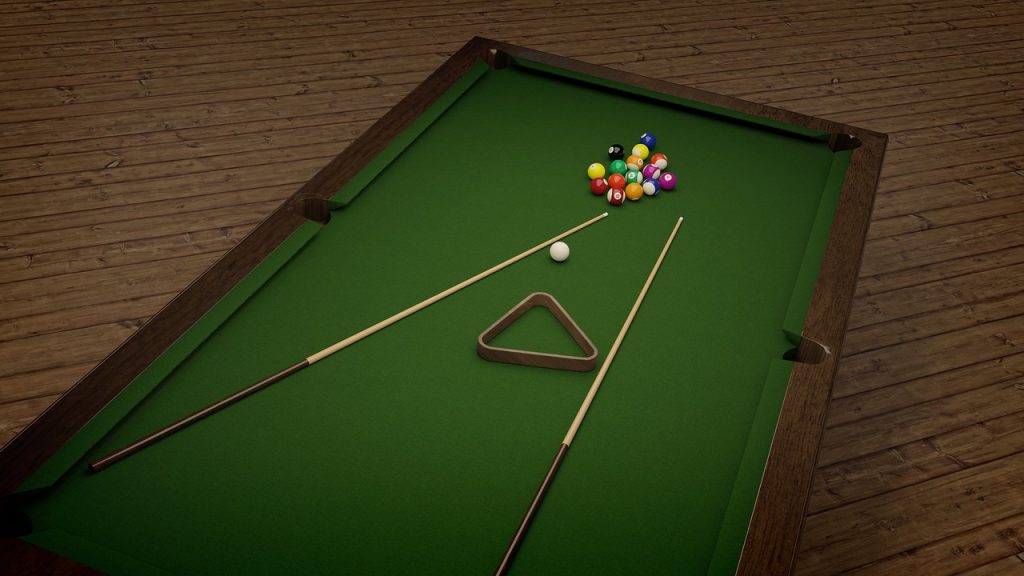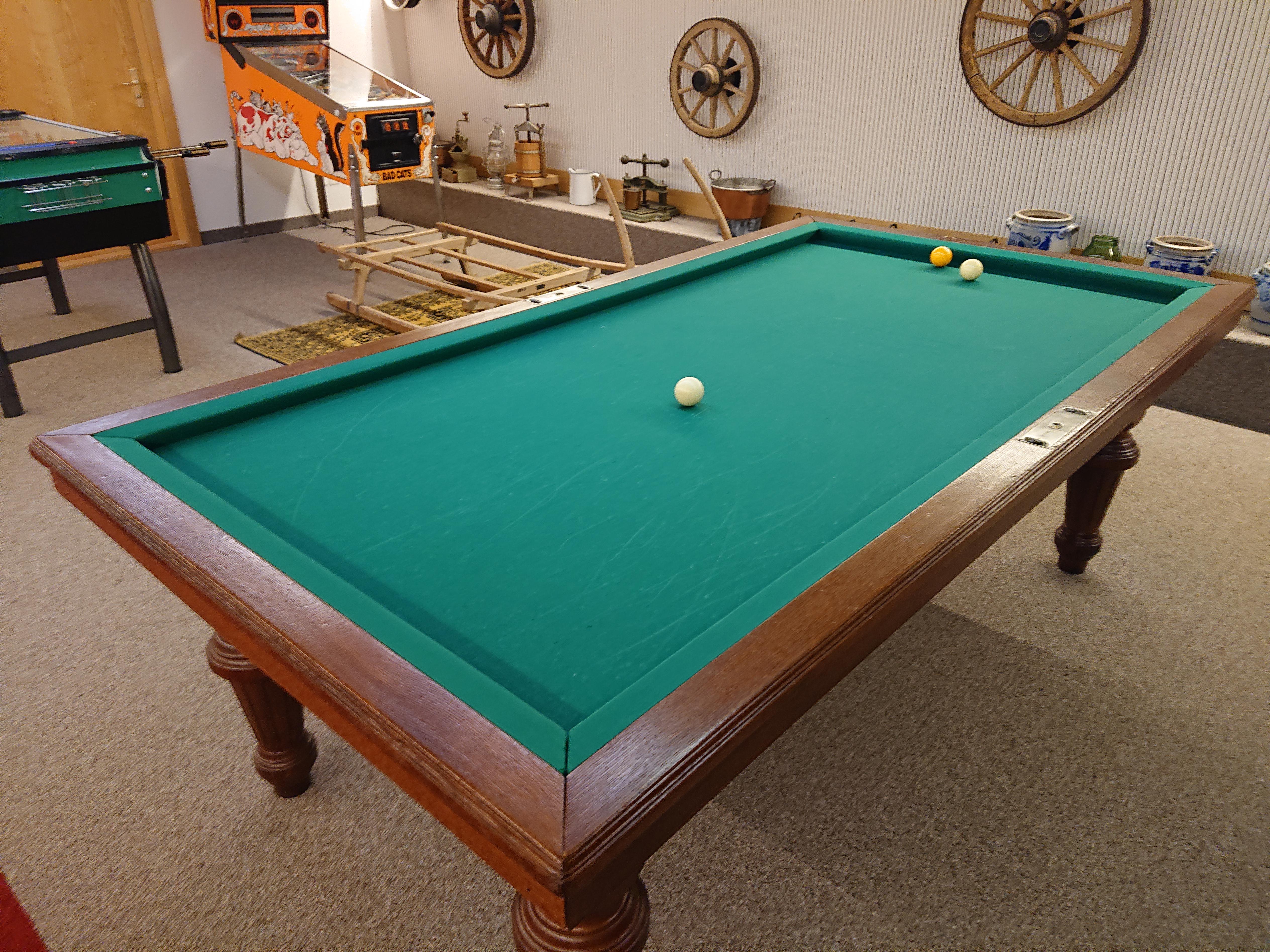Billiards vs. Pool
(A pool table with pockets)

Cue sports have long been a source of entertainment and camaraderie, drawing players and enthusiasts alike into the world of precision and strategy. Two terms often used interchangeably are “billiards” and “pool,” but are they really the same game? What is the difference between billiards and pool? In this guide, we’ll explore the nuances that set billiards and pool apart, shedding light on the differences that make each game unique.
Understanding the Basics:
Before diving into the distinctions, let’s establish a common ground by briefly exploring the basics of both billiards and pool. Billiards, as a term, is an umbrella encompassing various cue sports, including carom billiards, English billiards, and snooker. On the other hand, pool refers specifically to pocket billiards, a category within cue sports that involves sinking balls into pockets on a rectangular table.
Table Design and Size:
One of the most apparent differences between billiards and pool lies in the design and size of the playing tables. Billiards tables are typically larger, with dimensions ranging from 10 to 12 feet. These tables have no pockets and are used for carom billiards and English billiards. In contrast, pool tables are smaller, typically ranging from 7 to 9 feet, and feature pockets at each corner and in the center of the longer sides.
Although smaller than 10 or 12 ft, here is an example of a “billiards” (not pocket billiards) table with no pockets.
(A traditional billiards table with no pockets)

Balls and Cues:
The balls used in billiards and pool also differ, contributing to the distinct characteristics of each game. Billiards employs three balls – one red, one yellow, and one white. The absence of pockets means that players must rely on precise shots and ball positioning to score points. On the other hand, pool uses a set of 16 balls, including a cue ball. The balls are divided into two groups – solids and stripes – and the objective is to pocket all of one’s designated balls before sinking the 8-ball.
Scoring and Rules:
Transitioning from one game to the other requires an understanding of the scoring and rules unique to each. Billiards scoring is based on points earned through successful caroms or cannons, depending on the specific variant being played. Meanwhile, pool employs a simpler scoring system, with each ball pocketed carrying a designated point value. The game concludes when a player successfully sinks the 8-ball after pocketing all their designated balls.
Popular Variants
Within the realms of billiards and pool, there exist popular variants that enthusiasts often engage in. English billiards, for instance, is a form of carom billiards played on a rectangular table with three balls. Snooker, another popular billiards variant, involves 21 colored balls and a white cue ball, with players aiming to score points through strategic potting.
In the realm of pool, eight-ball and nine-ball are widely played variants. Eight-ball, perhaps the most common form of pool, requires players to pocket all their designated balls and then sink the 8-ball to secure victory. Nine-ball, on the other hand, involves players pocketing balls in numerical order, with the 9-ball as the final target.
Strategy
Beyond the tangible differences in equipment and rules, the strategic elements of billiards and pool diverge significantly. Billiards demands a high level of precision and strategic foresight, as players must navigate the table without the aid of pockets. The focus is on controlling the positions of all three balls to set up favorable opportunities for scoring.
In pool, strategic elements involve both offensive and defensive maneuvers. Players must consider not only potting their designated balls but also preventing their opponent from doing so. This adds an extra layer of complexity, as successful players need to balance offensive prowess with strategic defensive play.
Skillset and Technique:
The skillset and technique required for success in billiards and pool also vary, making each game uniquely challenging. Billiards players must master the art of caroms and cannons, relying on precise angles and ball control. Pool players, on the other hand, need adept cue ball control for position play and skillful potting to secure victories.
The Cultural Impact:
The cultural impact of billiards and pool further underscores the distinctions between the two. Billiards, with its rich history and associations with royalty, has been a traditional pastime in Europe for centuries. The elegant atmosphere surrounding billiards aligns with its refined nature.
Pool, on the contrary, has a more relaxed and accessible cultural image, often associated with bars, clubs, and casual social settings. The popularity of pool in the United States, especially during the mid-20th century, contributed to its widespread recognition as a recreational sport.
While both billiards and pool involve striking balls with a cue on a felt-covered table, the similarities largely end there. The presence (or absence) of pockets, the number of balls used, and the scoring systems create vastly different strategic landscapes. Mastering each game requires a unique approach, and understanding these differences is key to success on the green felt battlefield.
A little more detail: The Precision and Position play of Billiards
Traditional billiards, often referred to as carom billiards, is played on a pocketless table with only three balls: two cue balls (one for each player) and a red object ball. The objective is to score points by making your cue ball contact both the other cue ball and the red ball in a single shot. This might sound simple, but the absence of pockets dramatically alters the strategic focus.
In billiards, position play is paramount. Every shot must be carefully planned not just to score, but also to leave your cue ball in a favorable position for the next shot. This often involves intricate calculations of angles, ball speed, and cushion rebounds. Players must think several shots ahead, anticipating their opponent’s moves and setting traps to force errors.
Defensive play is also crucial in billiards. Since there are no pockets to offer a quick end to a poorly executed shot, a bad shot can leave your opponent with an easy scoring opportunity. Therefore, players often opt for safety shots, where they prioritize leaving their cue ball in a safe position, even if it means sacrificing a chance to score.
Billiards is a game of finesse and control. The emphasis is on precision and subtle adjustments to ball speed and angle. Power shots are rarely necessary and can often disrupt the delicate balance of the game. Instead, players rely on a smooth, controlled stroke to achieve the desired outcome.
Pool: A Game of Offense and Opportunity
Pool, on the other hand, is played on a table with six pockets and utilizes a set of 16 balls: a cue ball and 15 object balls. The most common variations of pool, such as eight-ball and nine-ball, involve pocketing balls in a specific order to win the game. The presence of pockets introduces a whole new dimension to the strategy.
In pool, shot selection is critical. Players must constantly assess the table, identifying the best opportunities to pocket balls while also considering the position they will leave for their next shot. This requires a keen understanding of angles, ball trajectories, and the spin that can be applied to the cue ball.
Offensive play is the name of the game in pool. While defensive shots are sometimes necessary, the primary focus is on pocketing balls and maintaining control of the table. This often involves taking calculated risks, attempting difficult shots in order to gain an advantage.
Cue ball control is essential in pool. Players must be able to manipulate the cue ball’s speed, spin, and trajectory to ensure they not only pocket the target ball but also leave themselves in a good position for the next shot. This requires a mastery of various cueing techniques and an understanding of how the cue ball reacts to different types of contact.
Key Strategic Differences Summarized
Here’s a table summarizing the key strategic differences between billiards and pool:
| Feature | Billiards | Pool |
|---|---|---|
| Table | Pocketless | With pockets |
| Balls | 3 (2 cue, 1 object) | 16 (1 cue, 15 object) |
| Objective | Score points by caroms | Pocket balls in order |
| Primary Strategy | Position play, defense | Shot selection, offense |
| Emphasis | Precision, control | Power, cue ball control |
| Pace | Slower, more deliberate | Faster, more dynamic |
Conclusion:
In conclusion, while billiards and pool share a common ancestry in cue sports, their differences are both nuanced and significant. From table design and scoring to the strategic elements and cultural impact, each game has its unique flavor and appeals to players with different preferences and skills.
As you navigate the exciting world of cue sports, whether you find yourself drawn to the precision of billiards or the dynamic nature of pool, remember that both offer a challenging and enjoyable experience. So, grab your cue, chalk up, and explore the subtle yet fascinating distinctions that make billiards and pool two distinct games within the broader realm of cue sports.
Different cue sports: https://en.wikipedia.org/wiki/Cue_sports
9 ball fouls and penalties: https://billiardsguru.com/9-ball-fouls-and-penalties/
Discover more from Billiards and Pool
Subscribe to get the latest posts sent to your email.